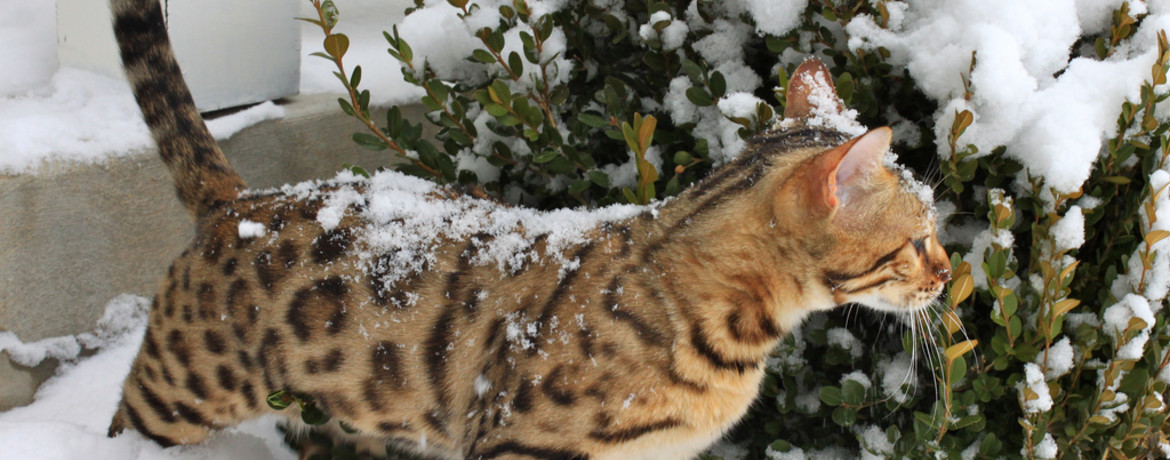Bengal Cat Breed Standards (FARUS system)
OVERALL IMPRESSION: The Bengal cat is a domestic cat that has the physical characteristics of the Felis Bengalensis wildcat (Asian leopard cat). Sizes from medium to large. A harmoniously built animal in excellent physical condition with a lively, balanced temperament.
HEAD: small in proportion to the body, but not too small. In the form of a wide modified wedge with rounded contours. In length more than in width. In adult cats, more developed jaws are allowed. Cheekbones are high, prominent.
PROFILE: smooth lines, slightly outlined soft transition from forehead to nose in the form of a small depression. The length of the frontal part of the skull is longer than the length of the nose.
CHIN: strong, well developed, located in line with the nose and upper lip. Gently rounded in profile.
NOSE: wide, medium length, nose mirror slightly convex.
MUZZLE: wide and full with pronounced, well-filled vibriss pads.
EARS: medium to small, wide at the base, rounded at the top. Small brushes on the inside of the ears are allowed, brushes are not allowed. There is a spot on the outside of the ear in the form of a thumbprint. The ears are located closer to the occipital part of the head in such a way that when viewed in profile, the entire head is in front of the ears. The ears are set wide and low enough, continuing the lateral lines of the head when viewed from the front, and slightly tilted forward when viewed in profile. The placement of the ears is very important.
EYES: oval, large, but not convex, widely spaced, slightly obliquely set. The characteristic look of a nocturnal predator. The color is bright, saturated in accordance with the color of the wool.
NECK: thick, muscular, long, in proportion to the body.
BODY: long and strong, large in relation to the head, but not oriental. The backbone is strong. The body is very muscular, especially in tomcats.
LEGS: medium length, muscular, not graceful. The hind legs are higher than the front legs, which gives the Bengal gait a characteristic feature of a crouching beast.
PAWS: large, round, with five toes on the front, and four on the hind legs.
TAIL: long, thick, slightly tapering to a rounded tip. The tail of a bengal is significantly different from the tail of a domestic cat. The Bengal carries the tail low, like a leopard, characteristically wrapping the end of the tail up.
COAT: short (longer hair is allowed in kittens), dense, unusually soft to the touch, preferably shiny, shining, with the effect of the so-called glitter (glitter). red, yellow or yellow-green. In white and two-colored cats, the eyes can be blue or differently colored.
COLOR: Brown Tabby (spotted / rosette - leopard color), Snow (snow background color), Seal Sepia (the darkest snow color - "cinnamon" on a dark cream background) and Seal Mink (Tonkin color - "mink", from cream to golden-sable) in two versions of tabby Pattern: Marble and Spotted. The nose and paw pads correspond to the color, taking into account the features characteristic of cats of white or bi-color color.
The peculiarity of the Brown Tabby color in Bengals is the wide color variability of the background (from reddish-brown and golden to dark yellow or muted yellow) and the pattern (from black and brown to reddish-brown and various shades of chocolate and cinnamon). A high degree of rufism (browning, yellowing of the coat) is preferable.
Marble: despite the fact that this color is a modification of the classic marble pattern, it should, if possible, differ from the usual "bull's eye". The elements of the drawing stretch out and seem to flow in a horizontal direction, which is especially noticeable when the cat's body is stretched. Preference is given to cats whose color has three tones: background color, pattern color and a dark contour around the elements of the pattern. The elements of the drawing should be of a distinct shape with clear contours and contrast as much as possible with the background color. The belly should be spotted.
Sepia, Mink and Lynx color variations should have no differences between the color of the points and the color of the body pattern, or these differences should be minimal.
Spotted: Spots should be placed randomly or in a horizontal direction. The spots can be solid or in the form of closed or torn sockets. The rosettes are two-tone - a bright inner color, a clear contour. Sockets are preferable. Vertical placement of spots is unacceptable. A residual marble pattern of elongated shape on the shoulders is acceptable. The elements of the drawing should be of a distinct shape with clear contours and contrast as much as possible with the background color. The belly should be spotted.
Sepia, Mink and Lynx color variations should have no differences between the color of the points and the color of the body pattern, or these differences should be minimal.
All non-traditional colors are registered in the AOV class.
DISADVANTAGES: The head of the oriental type. Lightweight body. Weak chin. Streakiness, vertical arrangement of spots, marbled color with an obvious "bull's eye". The color of the points is too dark compared to the color of the pattern on the body of the Sepia, Mink and Lynx color variations. The presence of distinct medallions or buttons. Long or coarse hair.
DISQUALIFICATION: aggressiveness. Curvature of the tail. Obvious signs of ill health. No spots on the abdomen.
ACCEPTABLE CROSSES: no
Score scale
HEAD (30)
Skull................................................................. 5
Profile........................................................... 5
Ears ................................................................... 5
Eyes ................................................................ 5
Muzzle and chin .............................. 5
Neck ................................................................... 5
BODY (20)
Housing ............................................................ 10
Legs and Paws ................................................... 5
Tail............................................................... 5
WOOL (10)
Texture, length, quality ...................... 10
COLOR (35)
Coat color............................................... 15
Drawing and contrast .................................... 15
Eye color ...................................................... 5
BALANCE (5)

